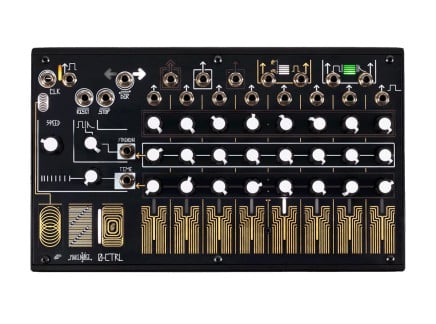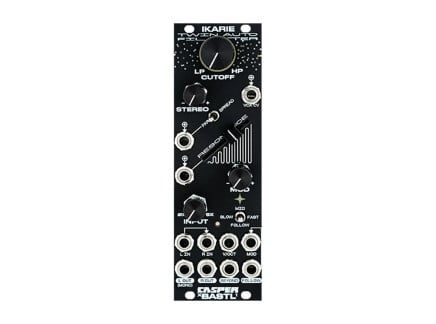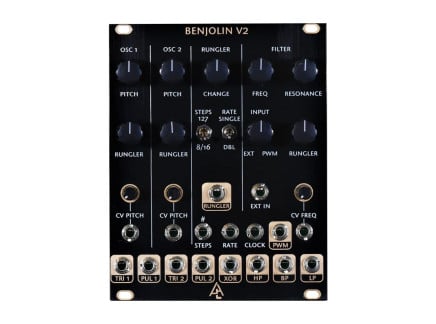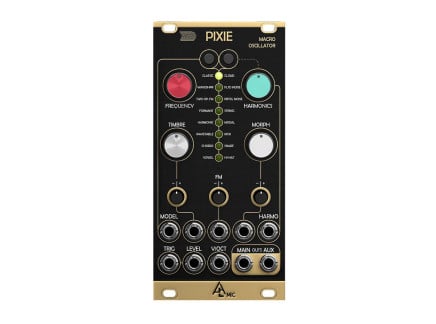How do you get into modular synths? The answer isn't always easy. Because there's no one right way to build your first modular system, it can be difficult to know where to get started...and in fact, it can be difficult to even know how to learn about getting started.
Luckily, performer-composer Sarah Belle Reid has dedicated much of her time to helping people find their path in modular synthesis. Though largely known for performing experimental music with trumpet and synthesizers, Reid is also an educator specializing in synthesis and music technology. After teaching electronic music at the University level for several years, Reid has created her own brand of modular synthesis training in the form of her thoughtful, thorough, and surprisingly deep online program Learning Sound & Synthesis. LS&S teaches everything from acoustics and synth history to an extensive overview of modular synth technique, aimed to leave participants ready to approach any synthesizer they encounter—even if they have no prior experience with synthesis, and even if they don't own any synthesis hardware.
Reid came by our shop to talk about several of her ideas about how to plan your first Eurorack system, and answered a lot of questions about how to get over the initial roadblocks you'll encounter when starting out. Refreshingly, her advice to us centers more around musical intention than technical specifications and module recommendations...so if you want a new way of thinking about planning your system, watch the video above and keep reading—and of course, if you're new to synthesis altogether (or if you're just looking to expand your practice!) check out Reid's Learning Sound & Synthesis program here.
Starting Out: How do You Choose Modules?
Perfect Circuit: Hey Sarah! Thanks for taking the time to talk to us about getting started with building a Eurorack system. We're curious how you yourself got into modular synths—and what has inspired you to dedicate so much time and energy helping others find their way?
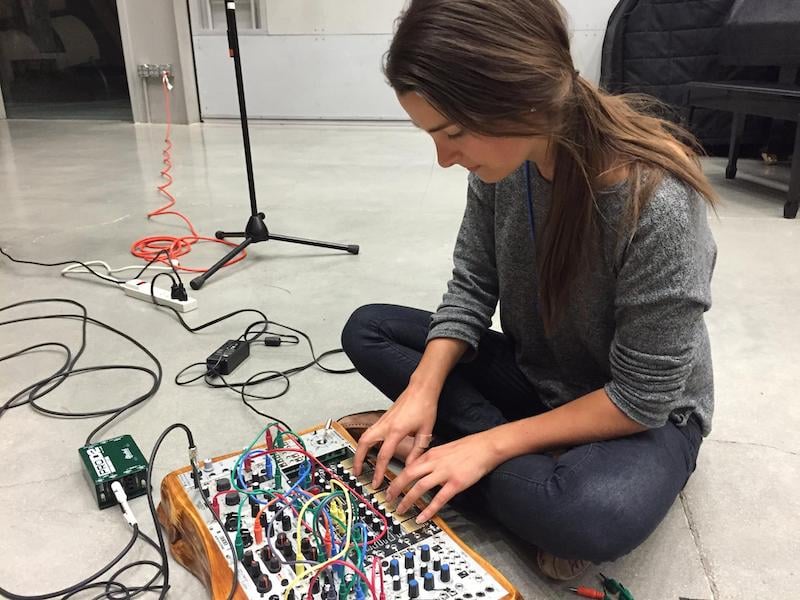
SBR: My first introduction for modular synths was during a concert that was taking place at CalArts—the school I did my graduate and doctoral studies at. I saw someone playing an improvised set on a small Eurorack system and remember being completely transfixed and bewildered during the entire performance. I remember thinking, what in the world is this incredible thing? I'm pretty sure a lot of people can resonate with that kind of feeling! I ran (literally) up to the performer after his set was over and asked a million questions, which led to us becoming good friends. From there, I discovered that there were a couple of vintage Serge modular synths in one of the studios at my school, so I slowly started to explore those.
It took me many years before I actually started to feel comfortable playing the modular systems. As someone who was coming from a very traditional, acoustic (and non-technical) musical background, the learning curve was significant for me and I spent many very long hours staring blankly at the modules wondering why I couldn't get any sound out of them. But when it finally DID start to click, and I was able to start weaving together my acoustic and electronic musical practices, it was like an entire new world of sonic possibilities opened up in front of me! I think that is why I'm so passionate about teaching this topic—I see so many people get overwhelmed or discouraged by the initial process of getting started that they put it off or give up prematurely. I understand those feelings and want to help people understand that they absolutely can learn to make music with modular synths if they want to, and that it actually doesn't have to be such a daunting thing to learn!
PC: In your video, you start out with (in our opinion) some pretty strong advice—if you're planning a hardware modular setup, you should start with a small system. Why do you think this is the best approach?
SBR: I always recommend starting out small, for a few reasons. First, it really helps to cut through that overwhelm that so often accompanies learning modular synthesis—when you focus on just one or two modules at a time, you can really get to know them in a deeper way. In the long run, this will give you so much more fluency and confidence in your instrument and workflow.
The second reason why I recommend starting small is because Eurorack modules are often WAY more versatile that people might realize. For example, you can use a filter as a sound processor (the way you most commonly would), or you can use it to generate tones all on its own by making it self-oscillate or even percussive sounds by pinging it from a clock or trigger source. An oscillator can produce steady tones if used conventionally, or chaotic, noisy, unpredictable patterns if patched back into itself to produce feedback. The key takeaway here is that even just a couple of modules can often lend themselves to a huge range of sounds—taking time to explore every nook and cranny of a module can reveal entire new sonic worlds, without needing to expand your system physically. Plus, it's fun to explore in this way!
And finally, I recommend starting small simply because it makes everything more affordable!
PC: When starting out small, though, how do you decide what the first module(s) should be?
SBR: That's a great question, and there really isn't one right answer—it depends a lot on your personal interests musically. That said, it can be useful and most rewarding to start off with some kind of flexible sound source, such as a complex oscillator or sampler. Other fun options are things like the Benjolin, which is a single module that contains two oscillators, a filter, and some internal chaotic modulation. For a long time, my personal synth setup consisted of nothing but a Benjolin and a mixer—it's a great choice if you're interested in being able to access more unpredictable, noisy textures in addition to your regular oscillator voices.
Of course, there's a lot more out there as well: I also really enjoy the Make Noise Morphagene, which allows you to chop up and manipulate samples in a lot of really interesting ways. If you're interested in more aggressive, rhythmic music, you could check out Noise Engineering's Basimilus Iteritas Alter, or if you're interested in a sampling of different techniques, you could check out Mutable Instruments's Plaits. There's something out there that'll lend itself to basically any kind of music-making, so starting out with something that is inspirational to you and speaks to you musically is always the right way to go.
Whatever direction you decide to go in, my advice is simply to look for something that has a bit of depth to it sonically, so that it can play multiple roles in your music. If you're feeling overwhelmed about choosing the "right" first module, just go with your gut—do some research, watch some demo videos, and see what excites you the most musically! There are no "wrong" first steps...and besides, the beauty of modular is that you can go anywhere from anywhere!

PC: You also talk in the video about balancing between these main sound sources/processors and control sources. When picking out control sources and other modules to augment your setup, how do you know what you need first? Does everyone need envelopes, or LFOs? Or do you have any general advice for planning past the first couple of modules?
SBR: I think one of the best ways to build a Eurorack system is to let your instrument grow along with your musical needs. It's rare to find two modular systems that are exactly the same, and deciding what specific control sources you want to work with should ideally be informed by your specific musical goals. So no, you don't NEED envelopes just because someone else might use them! Similar to sound sources, I'd recommend looking for control source modules that can provide a variety of functions, depending on how you use them. This will help you get a lot of variety out of a small system. I like the Make Noise Function, for example, because you can use them as LFOs, envelopes, you can use them to ping a filter, or run them at audio rate and produce tones, and with two of them together you can even use them as a crude sample and hold.
Another great benefit of starting small and building out slowly, is that it gives you time to discover your musical interests and ideal workflow—spend some quality time with just a couple of modules, and eventually your instinct will lead you to what's missing in your setup: maybe you want the ability to trigger sounds manually with a keyboard, or maybe you want to create articulations, or sequences, and so on. For me personally, I love being able to control and interact with the instrument in a very tactile way, so some kind of CV or MIDI controller is important. The Make Noise 0-CTRL is a great option because it can be a touch controller or a sequencer, and you have a lot of options for dynamically altering the speed, direction, and behavior of the sequence as it's in motion.
Of course, with modular synths there's definitely a bit of a "chicken and an egg" situation, in which you don't exactly know what you like or want until you know what's even possible in the first place, and discovering what's possible can tricky without buying a lot of modules. There's a great free virtual Eurorack program called VCV Rack that I recommend everyone checks out before investing in hardware gear. You can try out different types of modules and see what kind of tools you naturally gravitate toward.
PC: Of course, getting started also means that you need to plan out a case, too—and this is a place where we see a lot of people start to get confused. Once you start thinking about power supplies and module specs, things can get kind of overwhelming. What advice do you have for folks trying to pick out their first case?
SBR: One of the main things I think folks should consider is portability—it's tempting to want a big case, but if you have any desire to travel with your modular (even if it's just to the park or on holiday), you're going to want to choose a small case. I'm a big fan of the Intellijel Palette cases or 4MS Pods for cases that you can throw into a backpack. The Intellijel cases have built-in power supplies, and the 4MS pods come with the option for built-in power supply or not. These days, most powered cases come with enough power for the number of modules you could fit into them, so usually having enough power isn't a huge concern...but of course, it's always good to be aware of your power requirements.
Something else to keep in mind is module depth—some of these small cases are also quite shallow, so it's important to always double check the depth of your modules to make sure they'll actually fit in the case!
Starting Out: Learning to Make Music
PC: Alright, so here's something else we often see people get hung up on: having a modular synth is by no means the only requisite thing for starting to make music with a modular synth. People often assume that there's a lot of other knowledge and skill that you need before you can really start making music with a modular synth. Is that right? Or is that a misconception?
SBR: I think one of the amazing things about modular synthesizers is that you CAN make music with them without having a full technical understanding of what's going on. They are, by nature, exploratory instruments—you can try something out, immediately hear the results of that action, and decide whether you want to continue down that path or try something new. Something that I always try to emphasize in my teaching is that the best way to learn about modular synths is to play modular synths. You can study all the textbooks and module manuals in the world, but unless you actually jump in and touch/feel/make sound with them, you'll only ever have a surface level understanding of what's possible. I always compare this to trying to learn to swim by reading a book rather than getting in the water!
Now, of course, having an understand of synthesis, signal routing, and how your modules actually work is important too, but I don't believe that not having all the answers should ever stop someone from starting to make music. In fact, your musical intuition and creative goals are going to be HUGE assets in learning modular synthesis because they're going to provide context and purpose for everything else—I think it's important to balance all the technical skill development with time that's dedicated to nothing but open exploring, turning knobs, listening, and play.
 Screenshot of VCV Rack, the Eurorack Simulator DAW
Screenshot of VCV Rack, the Eurorack Simulator DAW
PC: So for people completely new to all of this, Eurorack can be kind of daunting. There are tons of manufacturers, tons of different approaches to designing modules, and if you don't already have a strong foundation in synthesis, even knowing how to pick out your first one or two modules can be really tough. What would you tell someone who is inspired by the idea of modular synths, but who is still finding their footing with synthesis in general? Where should they start out?
SBR: I mentioned VCV Rack earlier, but it's definitely worth a second mention. I would recommend starting there, before investing in any hardware gear. That way you can really take things slow, build one step at a time, and you can discover what kinds of sounds and modules you like. I know some people really want the physical interaction that comes with hardware gear, and that that's one of their main motivations for wanting to get into modular synthesis in the first place. VCV Rack can still be an awesome place to start, because you can connect it to external MIDI controllers quite easily, giving you the ability to interact with patches in a more hands-on way.
I use VCV Rack all the time in my personal musical practice, and it's also the primary tool I use to teach core synthesis concepts and patching in my online program Learning Sound & Synthesis. The great thing is that all of the concepts and techniques are universal, so if a student decides to invest in a hardware Eurorack synth once they've gone through the course and mastered synthesis, they'll be able to transfer everything over with ease.
PC: I know that, in teaching/talking about synthesis, you have a pretty strong focus on history and on the phenomenon of hearing/listening. Do you think these things are important for every synthesist? How can these things benefit electronic musicians?
I think that taking time to learn about modular synths, not only in terms of how they work, but also about when, how, why and by whom they were developed will only deepen your relationship with the instrument and provide you with valuable insight as to why it works the way it does. I like to look at the history of modular synthesis/electronic music because I feel like it adds so much depth, context, character, and meaning to this form of music-making—catching a glimpse into the minds of famous synth developers, learning from their successes and failures, gaining an understanding of how and why technology progressed in the way that it did... all of these things have had such a tremendous impact on how the whole Eurorack world has developed.
 Sarah Belle Reid at Moogfest 2018
Sarah Belle Reid at Moogfest 2018
PC: Two big hurdles we often see people run into are the general "when" and "how" of things. If you feel like there's some unknown thing in the way of getting started with a new workflow, it becomes easy to get overwhelmed. What advice do you have for musicians who are struggling finding the right time to get started with modular synths, or struggling to find the resources they need to learn?
SBR: First of all, for anyone experiencing these feelings of being stuck or overwhelmed: I completely understand the feeling. Learning about modular synthesis on your own by piecing together tutorials, manuals, and bits of advice from different folks can a be really difficult, frustrating process. It can feel like there's a never-ending list of terms, techniques, concepts, and tools you need to figure out before you can even start making music. When I was first getting started with all of this, I used to get in my own way A LOT—I'd worry about not having all the pieces worked out, so instead of creating and exploring freely I would often just get stuck and do nothing.
This is a big part of the reason why I created Learning Sound & Synthesis—to offer a complete curriculum that can guide someone step-by-step from the very beginnings of what sound and synthesis is, to building your first patches, to more advanced patching and composition strategies, to learning how to connect VCV Rack out to external gear, hardware synths, acoustic instruments, your studio, and more.
So, my main advice for someone who has been wanting to learn modular synthesis for ages but has been struggling to find the right time and/or resources to get started, is to know that you'll likely never have ALL the pieces in place, and (if you're lucky) there will always be more to learn. That's a good thing! Embrace the exploration and the journey, and just take things one step at a time. You'll be making beep bloops and swirling worlds of sound in no time.
Learning Sound and Synthesis

PC: Your course Learning Sound and Synthesis looks like a really thorough introduction to modular synthesis from a lot of different angles. How is the course structured? What is the curriculum like?
SBR: The core curriculum inside of Learning Sound & Synthesis is structured as seven main modules, each containing 10–15 video lessons. These start at the very beginning and walk you step-by-step through understanding the building blocks of sound, music, and synthesis, as well as the history of modular synthesis and how these instruments have developed over time. As the course progresses, you are guided through all the most important concepts and techniques in modular synthesis, including sound generation/processing, control voltage, patching, and dynamic signal routing. The modules take you from your very first patch into much more advanced generative, interactive, and complex patching strategies.
There's a big emphasis on implementing everything that you learn throughout the course (and making music!!) so I have included a couple of modules all about strategies for composition, performance, and improvisation with modular synths as well as a breakdown of my own personal processes. And finally, since I'm also a trumpet player, it was important for me to include a module all about connecting VCV Rack out to the external world—to use it to process acoustic instruments, control your hardware synths, or otherwise interact with the rest of your studio. Each module is accompanied by a workbook with a series of exercises, prompts, and activities to help you put everything you're learning into motion within your own personal musical practice.
Each module in this course has a lot of information, but everyone who enrolls gets lifetime access to the content, so they can go at their own pace and come back to the material as often as needed.
I think it's also really important to connect with other musicians and a supportive community when you're learning modular synthesis, which is why I've structured this program to also include a substantial synchronous component. There's a member's community from which I've seen many new collaborations and friendships emerge, and I also host 5 live group coaching calls on Zoom throughout the program. During these coaching calls I work with students directly to answer their questions, provide feedback, and help them overcome any technical or creative roadblocks. There are also a really fun way to meet and chat with folks from all across the world who are just as passionate and curious about modular synthesis as you are!
PC: Do students need hardware to get the most out of your course? And is this course designed for absolute beginners? Or will more experienced players find it useful as well?
No hardware is needed! I teach everything using VCV Rack, so you can get started without needing to invest in any gear. The program covers universal synthesis concepts that are transferrable to any hardware synth you might want to use in the future, so if you do decide to go that route, you'll be set.
I have structured this course so that both absolute beginners and more experienced synthesists can gain a lot from it. I've had folks enroll in the program who had already been patching for years, and they were able to discover gaps in their knowledge, or new ways of thinking about music-making and working with modulars that really deepened their relationship with their instruments. I think there is always room for growth, new experience, and new perspectives!

Learning modular synths can be daunting—but Reid's advice, at the end of the day, is quite sound: start out small, start making music immediately, and figure out how to grow your system from there. You'll never know what tools you need until you get your hands dirty and start making music...so even though it might seem like there's a whole world between where you're at now and where you want to be, the right first step is to start somewhere and see where it takes you. You don't need a huge, sprawling system all at one time, and you don't need a full studio of gear to make interesting music. In fact, we suspect that your music will be all the more interesting if you take your time getting to know your tools slowly, listening carefully all the while.
And of course, if you need a guide as you start out with modular synthesis, Reid is an excellent, thoughtful, and encouraging contender. If you're interested in signing up for Learning Sound & Synthesis, don't delay: enrollment is only open until Friday, December 11th 2020. We're told that this program will only open for enrollment a couple of times each year, so if you're looking for a structured, enriching, and thorough way to get into modular synths, now might be exactly the right time.

